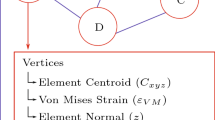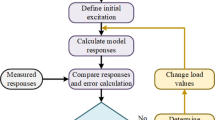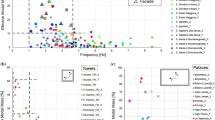Abstract
This paper considers off-line identification of spatial and temporal characteristics of a dynamic load, and is focused on the case of a limited number of sensors. Both elastic and elasto-plastic structural behaviours are taken into account. The identification is performed off-line, based on optimisation of modelled local structural responses, and—in the case of limited number of sensors—identifies an observationally equivalent load, which in a given sense optimally approximates the actual load. Compared to previous researches this approach allows to identify general dynamic loads of unknown locations, including multiple impacts and moving loads, and gives more insight into the identification process by distinguishing between the reconstructible and unreconstructible load components. Additionally, the problem of optimum sensor location is discussed.
Similar content being viewed by others
References
Adams R, Doyle JF (2002) Multiple force identification for complex structures. Exp Mech 42(1):25–36
Chan THT, Yu L, Law SS (2001) Moving force identification studies: theory. J Sound Vib 247(1):59–76
Dahlquist G, Bjørck A (2008) Numerical methods in scientific computing. To be published by SIAM, Philadelphia
Fukunaga H, Hu N (2006) Experimental impact force identification of composite structures. In: Proc. of 3rd European workshop on structural health monitoring, pp 840–847
Gaul L, Hurlebaus S (1997) Identification of the impact location on a plate using wavelets. Mech Syst and Syst Process 12(6):783–795
Hansen P (2002) Deconvolution and regularization with Toeplitz matrices. Numer Algor 29:323–378
Holnicki-Szulc J, Gierliński J (1995) Structural analysis, design and control by the virtual distortion method. Wiley, Chichester
Inoue H, Harrigan J, Reid S (2001) Review of inverse analysis for indirect measurement of impact force. Appl Mech Rev 54(6):503–524
Jacquelin E, Bennani A, Hamelin P (2003) Force reconstruction: analysis and regularization of a deconvolution problem. J Sound Vib 265:81–107
Jacquelin E, Bennani A, Massenzio M (2005) Analysis of a force reconstruction problem. Struct Eng Mech 21(3):237–254
Jankowski L, Wikło M, Holnicki-Szulc J (2007) Robust post-accident reconstruction of loading forces. Key Eng Mater 347:659–664
Kress R (1989) Linear integral equations. Applied mathematical sciences, vol 82. Springer, New York
Law SS, Chan THT, Zeng QH (1997) Moving force identification: a time domain method. J Sound Vib 201(1):1–22
Mackiewicz A, Holnicki-Szulc J, Lopez-Almansa F (1996) Optimal sensor location in active control of flexible structures. AIAA J 34(4):857–859
Martin MT, Doyle JF (1996) Impact force location in frame structures. Int J Impact Eng 18(1):79–97
Nocedal J, Wright S (1999) Numerical Optimization. Springer series in operations research. Springer, New York
Putresza JT, Kołakowski P (2001) Sensitivity analysis of frame structures—virtual distortion method approach. Int J Numer Methods Eng 50(6):1307–1329
Simo JC, Hughes TJR (1989) Computational inelasticity, interdisciplinary applied mathematics, vol 7. Springer
Tikhonov A, Arsenin V (1977) Solutions of ill-posed problems. Wiley, New York
Wikło M, Holnicki-Szulc J (2008) Optimal design of adaptive structures. Part II: Adaptation to impact loads. Struct Multidisc Optim. doi:10.1007/s00158-008-0242-7
Wu E, Tsai CZ, Tseng LH (1998) A deconvolution method for force reconstruction in rods under axial impact. J Acoustic Soc Amer 104(3):1418–1426
Author information
Authors and Affiliations
Corresponding author
Additional information
The author gratefully acknowledges the financial support of the Polish Research Projects DIADYN (PBZ-KBN-105/T10/2003) and MAT-INT (PBZ-KBN-115/T08/2004). Parts of this paper will be used in a coming book “Smart Technologies for Safety Engineering” to be published by John Wiley & Sons in 2008.
Rights and permissions
About this article
Cite this article
Jankowski, Ł. Off-line identification of dynamic loads. Struct Multidisc Optim 37, 609–623 (2009). https://doi.org/10.1007/s00158-008-0249-0
Received:
Revised:
Accepted:
Published:
Issue Date:
DOI: https://doi.org/10.1007/s00158-008-0249-0




